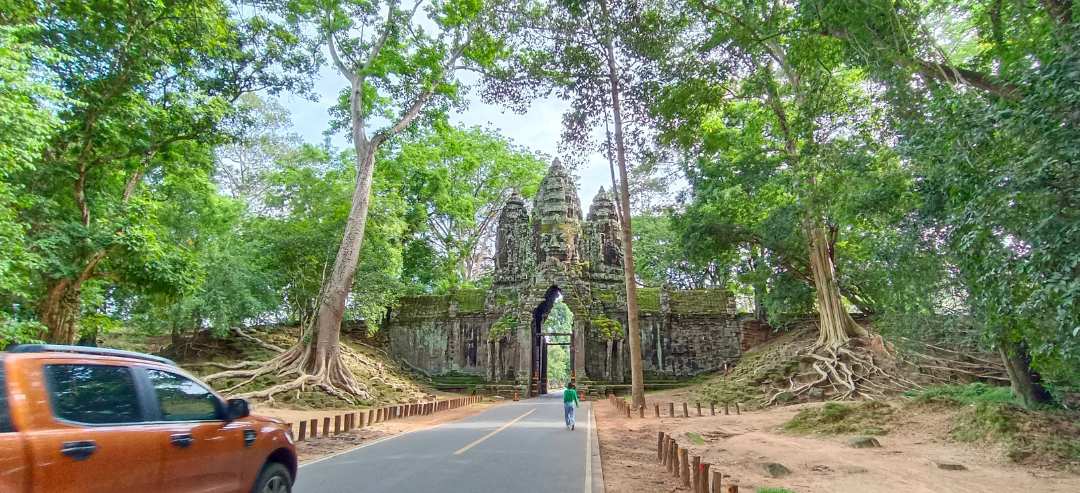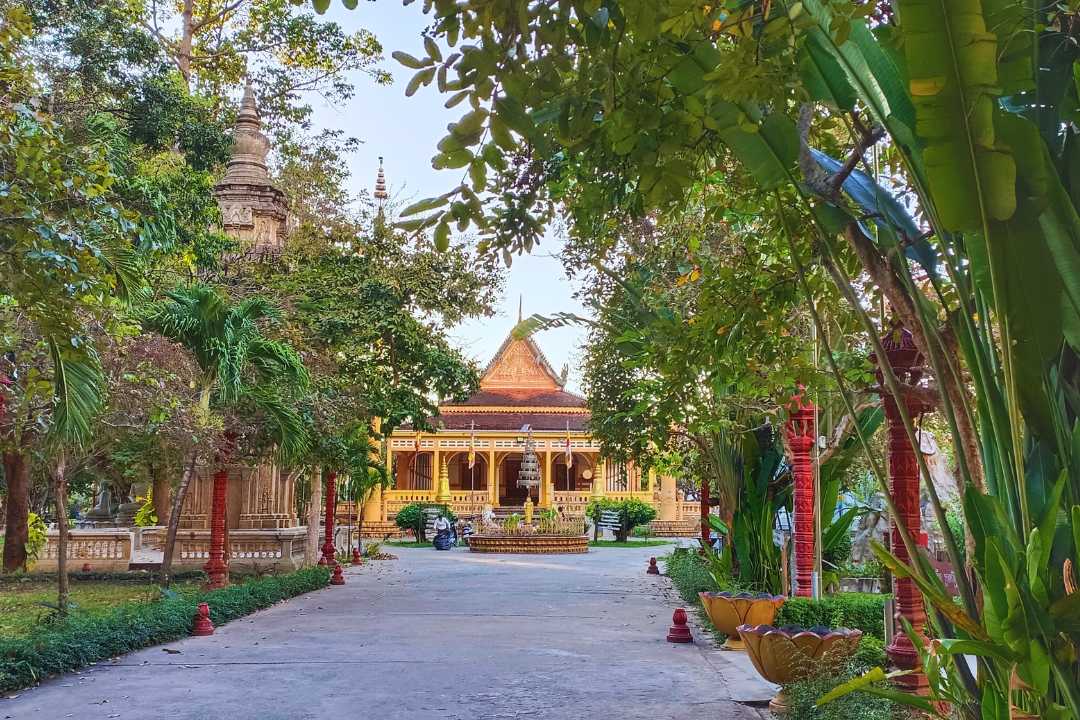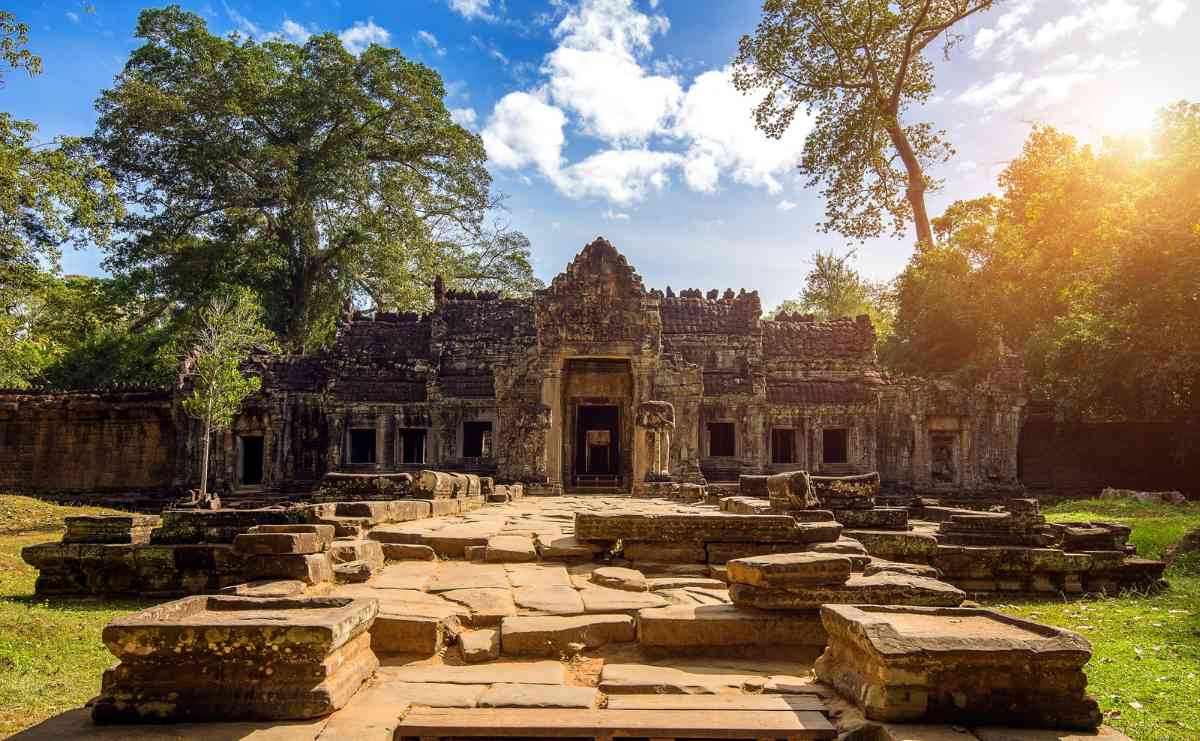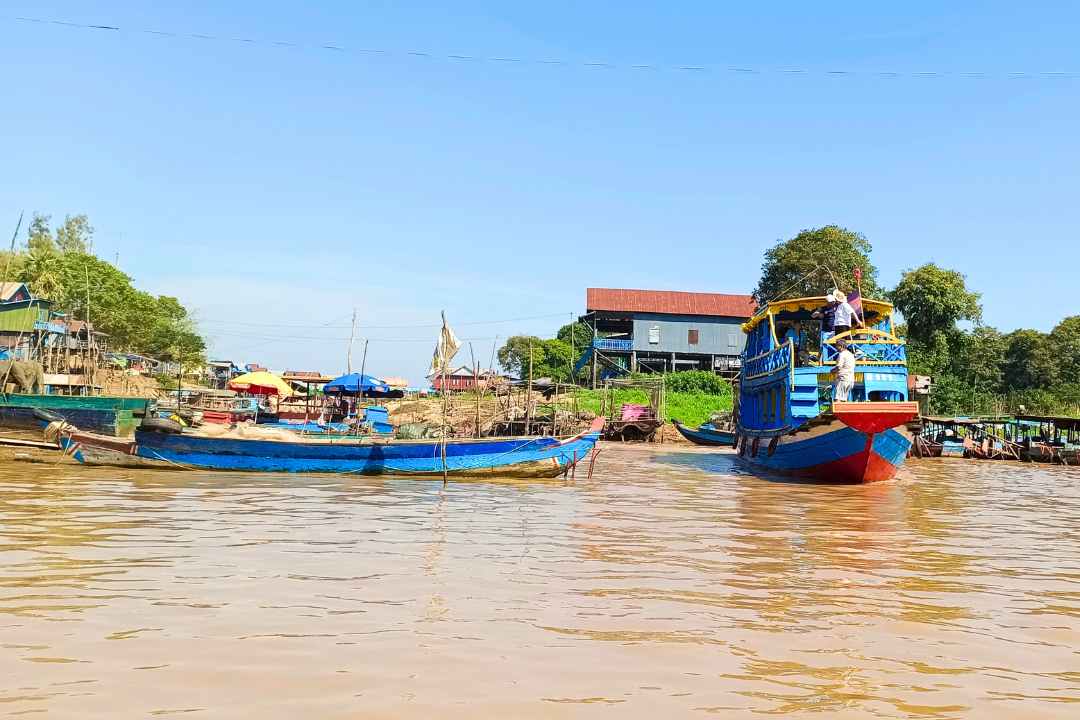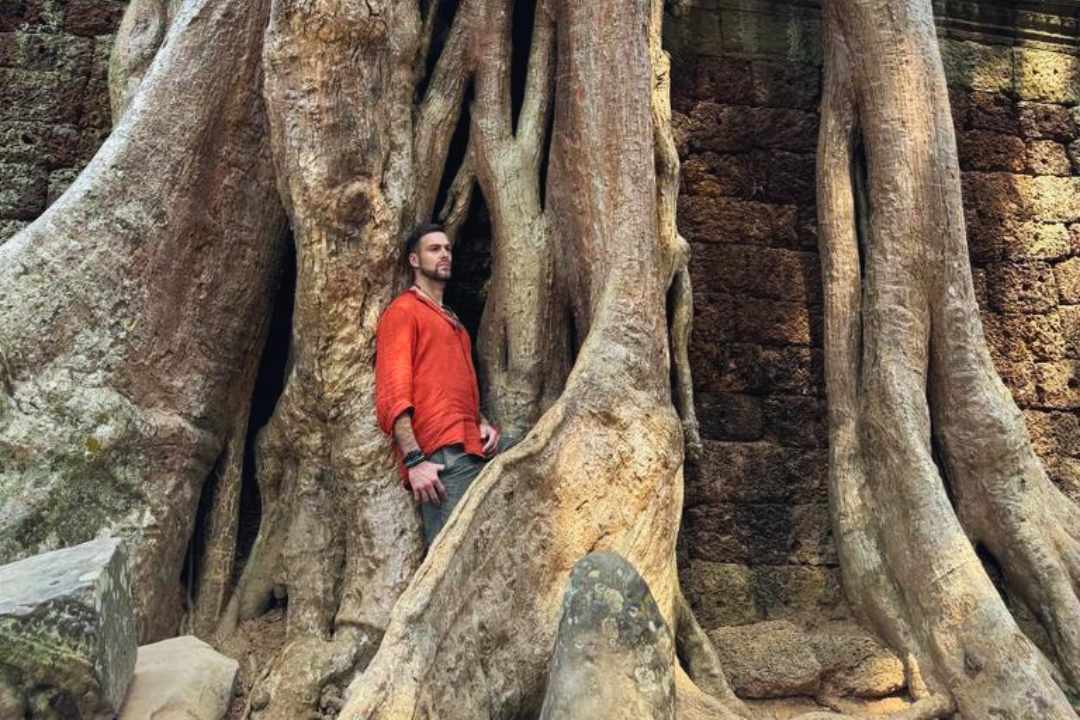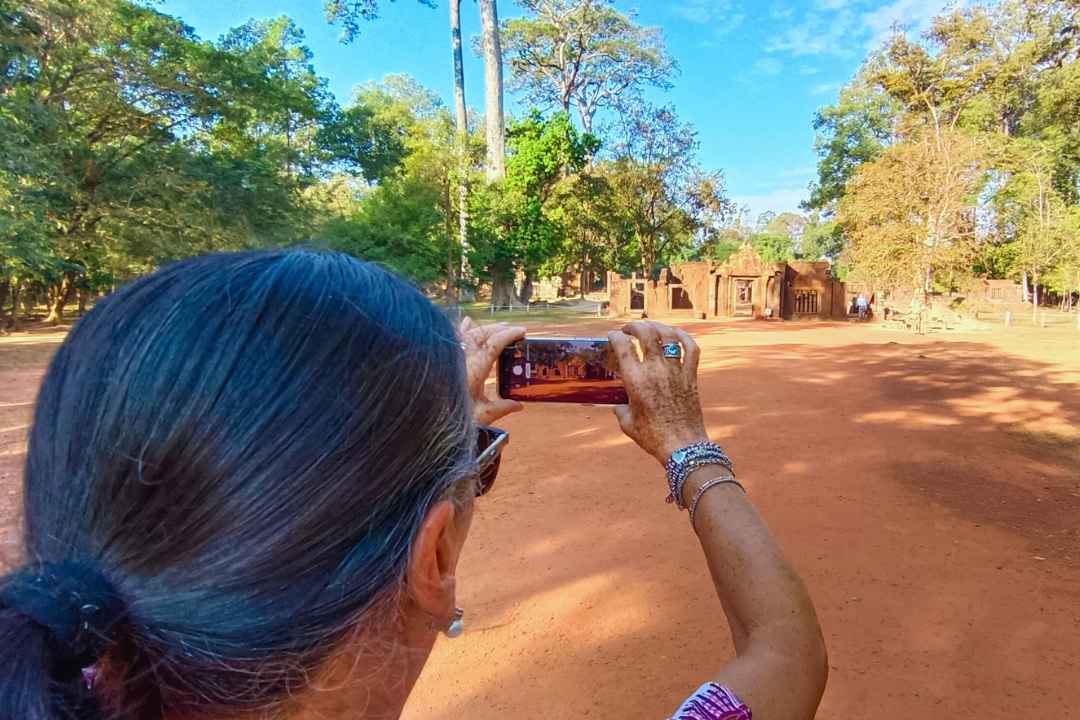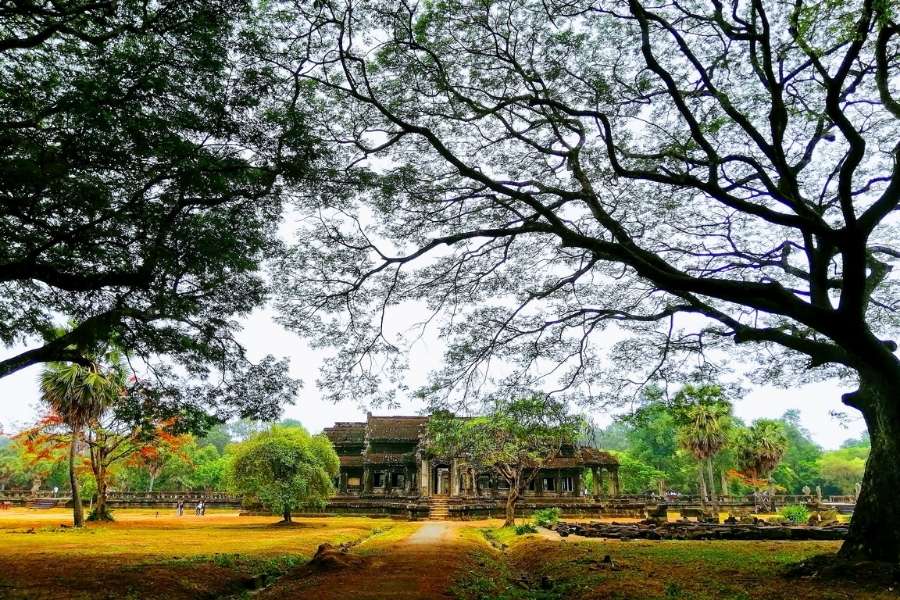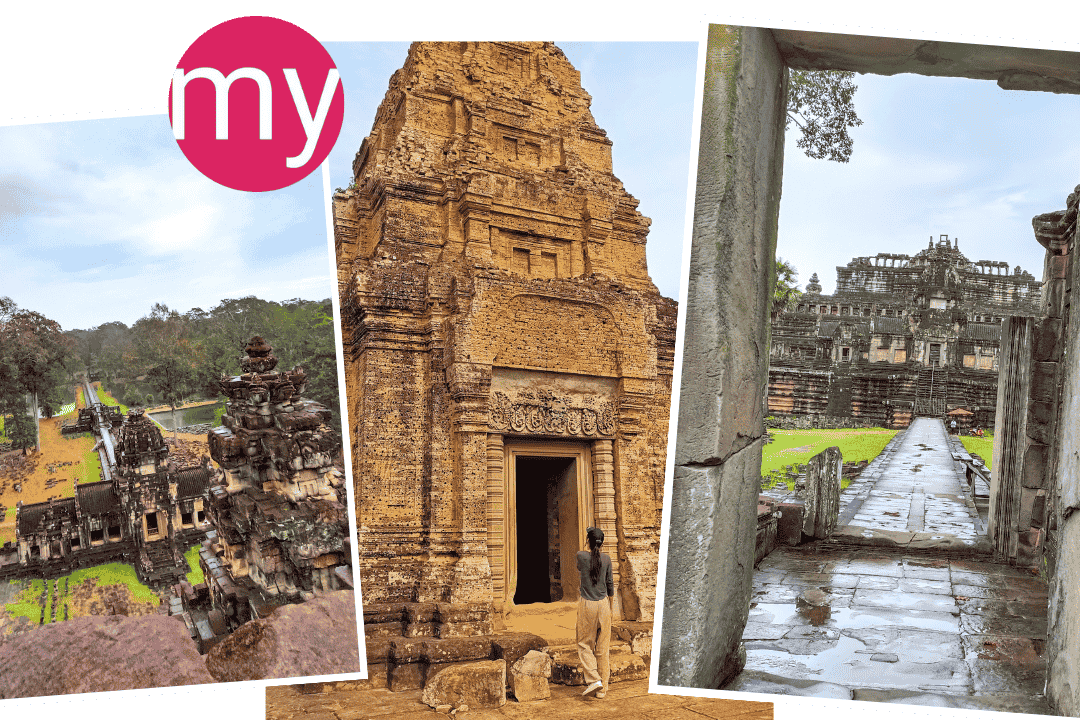Ta Nei Temple - The Ancient Jungle Temple - Cambodia’s Forgotten Story You Can Still Touch!
Step Into 800-Year-Old Stories, Walk Quiet Paths, Feel History Alive at Ta Nei Temple!
Looking for peace away from Angkor’s busy temples? Ta Nei Temple sits quietly in the forest, mostly forgotten but full of charm. This 800-year-old Buddhist sanctuary offers a rare chance to feel like an explorer in Cambodia’s famous Angkor Archaeological Park.
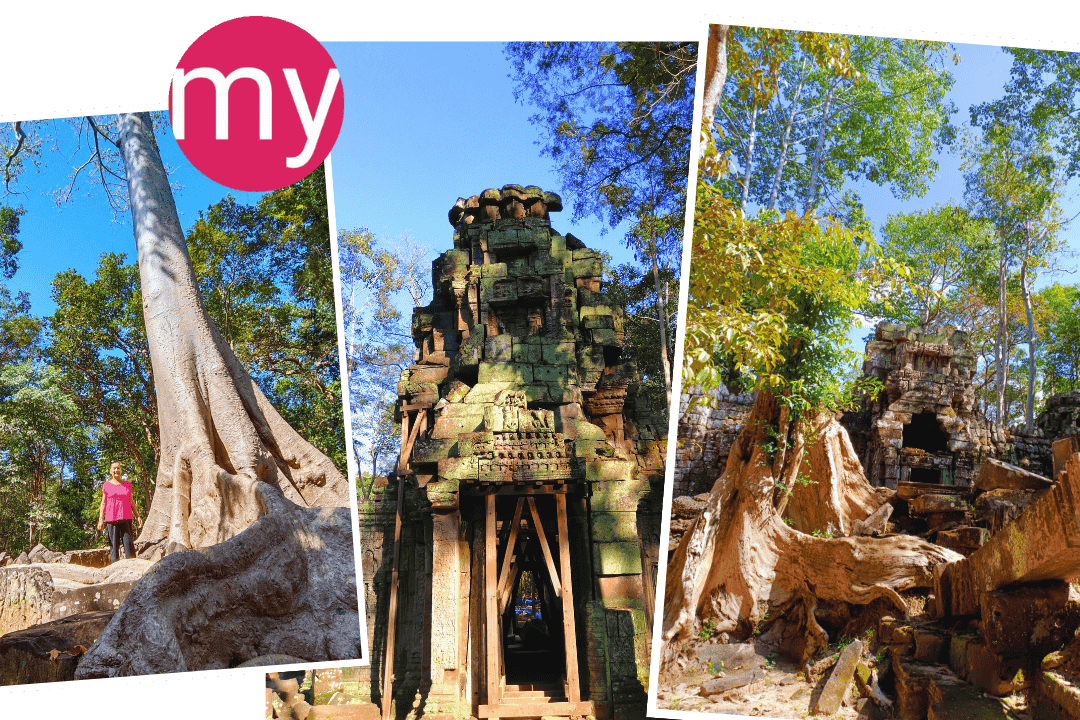
Ta Nei Temple – Where Ancient Stone Meets Jungle Mystery
Ta Nei Temple sits quietly in the forest, mostly forgotten but amazingly preserved. This 800-year-old Buddhist sanctuary offers peace and beauty you won’t find at Angkor’s famous spots. No ropes, no crowds—just you and history.
Ta Nei Temple Snapshot: Quick Facts About Ta Nei
Ta Nei Temple was built in the late 12th century during King Jayavarman VII’s reign. This small yet impressive structure follows the Bayon style architecture common to that period. Unlike popular spots like Angkor Wat or Ta Prohm, Ta Nei remains largely untouched, creating a special atmosphere where nature and history blend together.
Here’s what you need to know:
- Location: Northeast of Angkor Thom, near the East Baray reservoir
- Built: Late 12th century (approximately 1185-1190 CE)
- Builder: King Jayavarman VII
- Style: Bayon architecture
- Size: Small temple with central sanctuary and several gopuras (entrance pavilions)
- Best time to visit: Early morning (7:00-9:00 AM) for the best light and fewest people
- Visit duration: 45-60 minutes is perfect for exploring the site
The temple offers amazing photo opportunities, especially in the morning light when sun rays filter through trees onto the old stones. The east and west entrances provide stunning frames for photos, with tree roots and moss adding natural drama to your shots.
Key Takeaways:
- Morning Magic: Visit Ta Nei at 7:00 AM when the temple opens. Early morning light creates gorgeous rays through trees, and you’ll likely have the entire place to yourself.
- Royal Origins: King Jayavarman VII built Ta Nei Temple in the late 12th century as part of his Buddhist building program. The temple showcases his classic Bayon-style architecture with beautiful carvings.
- Jungle Setting: Unlike restored temples, Ta Nei’s partial ruins blend with the surrounding forest. Trees, moss, and roots create a natural atmosphere that feels authentic and peaceful.
- Easy to Combine: Ta Nei pairs perfectly with the nearby Angkor Zipline for an adventure-culture day. A short 5-10 minute drive connects these experiences.
- Conservation Success: Recent Japanese-Cambodian projects have carefully stabilized Ta Nei without removing its wild character. The East Gate restoration shows how preservation can work without over-restoration.
- Photography Haven: The mix of stone, light, and jungle makes Ta Nei incredibly photogenic. Bring your camera and look for scenes where moss meets carved stone.
- Budget-Friendly: Ta Nei requires no extra fees beyond your regular Angkor pass. This makes it a free add-on to your Angkor exploration.
- Authentic Experience: Many visitors say Ta Nei feels like “real exploration” compared to the theme-park atmosphere at crowded sites. You can touch the stones and move freely through the temple.
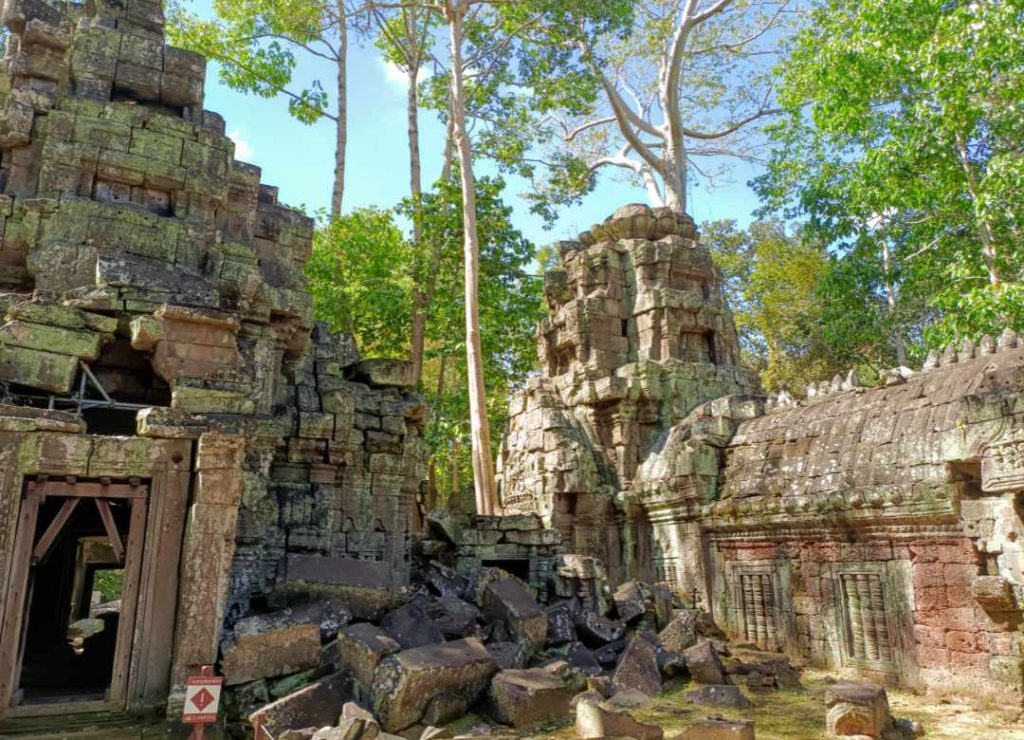
The History Behind Ta Nei’s Ancient Walls
Ta Nei stands as a testament to King Jayavarman VII’s ambitious building program. After uniting Cambodia, this great king launched numerous construction projects across his empire. He built Ta Nei Temple as a Buddhist shrine, part of his wide-spread efforts to establish Buddhism as the state religion.
Archaeological evidence suggests the temple was later modified under King Indravarman II, showing its continued importance. Originally dedicated to Buddha, the temple reflects the Buddhist shift that happened during Jayavarman VII’s rule.
For centuries after the Khmer Empire declined, Ta Nei was forgotten, swallowed by the surrounding jungle. French explorers rediscovered it in the early 20th century but focused their restoration efforts on larger temples. This neglect turned out to be a blessing – while other temples were heavily restored, Ta Nei kept its authentic charm and wild setting.
Today, the temple holds special value for archaeologists studying how Khmer temples looked before modern restoration. Its relatively untouched state provides rare insights into original construction techniques and natural decay processes.
Architecture: The Beauty in Ta Nei’s Design
Ta Nei showcases classic Bayon style architecture, with distinctive features that mark Jayavarman VII’s building projects. The temple follows an east-west orientation, with entrance gates (gopuras) on multiple sides.
The temple layout includes:
- Central sanctuary: A cruciform structure that originally housed Buddha images
- Inner enclosure: Surrounded by a gallery with entry pavilions
- Eastern gopura: The most elaborate entrance, recently restored
- Western gopura: Contains beautiful lintels now placed on the ground
- Libraries: Small buildings that once stored sacred texts
Walking through Ta Nei reveals amazing Buddhist carvings and decorative elements. Look for the beautiful devatas (female divinities) carved on walls and pillars. Some pediments show scenes from Buddhist tales, though many are damaged or fallen.
What makes Ta Nei special compared to similar temples like Ta Prohm or Ta Som is its size and state. While Ta Prohm is famous for its tree-strangled ruins, Ta Nei offers a similar atmosphere on a smaller, more intimate scale – and without the crowds.
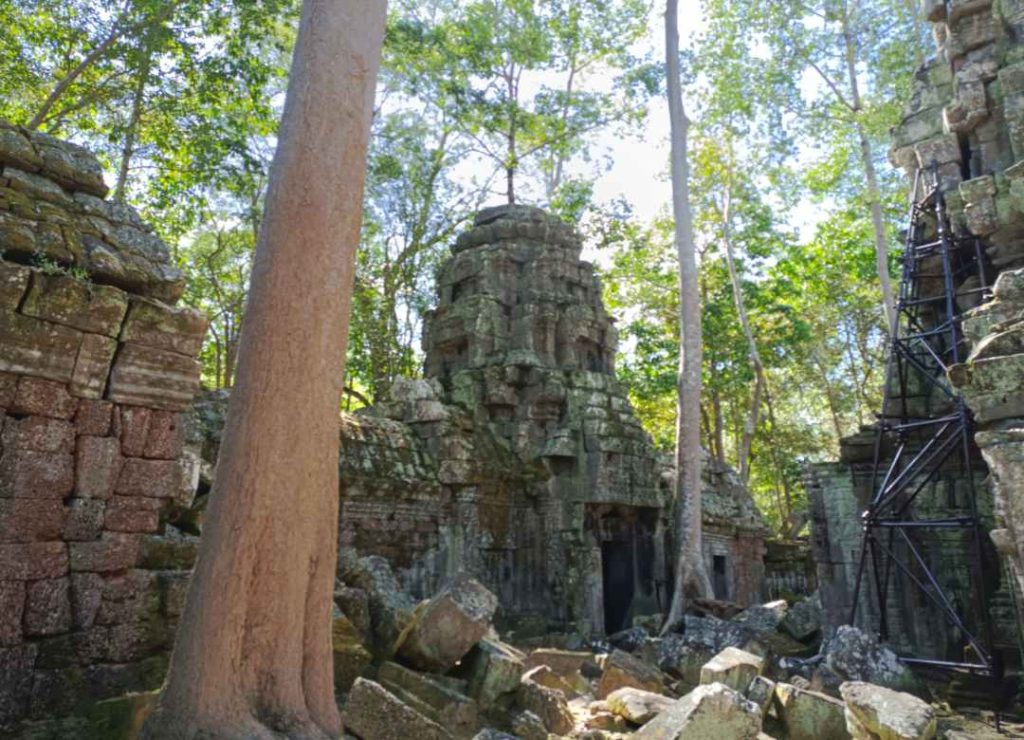
Nature’s Embrace: Ta Nei Temple Jungle Setting
One of Ta Nei’s most striking features is its jungle setting. Tall trees surround the temple, their canopies creating a green ceiling above the stone structures. This natural environment adds greatly to the temple’s appeal.
The forest around Ta Nei hosts diverse plant and animal life:
- Flora: Strangler figs, tetrameles trees, ferns, moss, and various tropical plants
- Fauna: Birds (like Asian paradise flycatchers and black-naped monarchs), butterflies, small reptiles, and occasionally monkeys
- Seasonal changes: During rainy season (May-October), the vegetation turns intensely green and moss covers more of the stones; in dry season (November-April), the lighting through leafy gaps becomes more dramatic
This blend of nature and architecture creates what many visitors describe as a “magical” atmosphere. The sounds of forest birds and insects replace the noise of tourist groups found at larger temples.
Conservation experts face a careful balancing act here – protecting the temple structures while preserving the natural setting that makes Ta Nei special. Too much vegetation clearance would ruin the atmosphere, while no management would eventually lead to structural collapse.
To contextualize Ta Nei’s situation within Angkor’s recent trends
Tourist visits to Angkor Park have gone up since COVID-19, but they’re still not as high as before. The park had 2.2 million foreign visitors in 2019. This number fell to about 400,000 in 2020 and dropped even more to just 20,000 people in 2021.
Things started to get better in 2022 with 287,454 visitors. The next year saw 798,069 tourists coming to the park. For 2024, experts think about 1,020,000 people will visit. Money from ticket sales has followed a similar pattern.
Ta Nei Temple gets far fewer visitors than other parts of the park. Most days it has almost no tourists at all. In 2023, maybe 8,000 people visited Ta Nei (about 20 per day). If more people come to Angkor in 2024, Ta Nei might get 30-40 visitors on days when tour groups include it.
For 2025, experts think 1.2-1.3 million foreign tourists will visit Angkor Park. Chinese tourists will likely make up a big part of this growth.
| Year | Foreign Visitors to Angkor Park | Ticket Revenue (USD) |
|---|---|---|
| 2019 (pre-pandemic) | 2,200,000(record high) | $99 million |
| 2020 | ~400,000(–82% vs 2019) | $18.6 million(–81%) |
| 2021 | ~20,000(virtually no tourism) | $1.4 million |
| 2022 | 287,454 | $11.5 million |
| 2023 | 798,069 | $37 million |
| 2024 (est.) | ~1,020,000 (≈28% ↑ vs 2023) | ~$48 million (≈30% ↑) |
| 2025 (proj.) | 1.2–1.3 million (continued recovery) | $60+ million (approaching 2019 levels) |
Preservation Efforts: Saving Ta Nei for Future Generations
Ta Nei currently exists in a semi-ruined state, which is part of its charm. However, important conservation projects are helping protect it from further decay.
Since 2017, a significant technical cooperation project between Cambodia’s APSARA National Authority and Japan’s Tokyo National Research Institute for Cultural Properties has focused on Ta Nei’s conservation. This project aims not just to save the temple but to develop sustainable heritage management approaches.
Key conservation work includes:
- East Gate restoration: Stabilizing the tilting structure and closing dangerous cracks
- 3D documentation: Creating precise digital models of the entire temple
- Structural analysis: Studying foundation issues and developing solutions
- Environmental monitoring: Tracking how humidity and temperature affect the stones
- Training local experts: Building Cambodian capacity for ongoing maintenance
The conservation philosophy follows a middle path – preventing collapse while maintaining Ta Nei’s authentic ruined character. Unlike heavily reconstructed temples elsewhere in Angkor, Ta Nei will keep its “romantic ruin” quality even after conservation work.
This approach serves as a model for how smaller, less-visited temples can be preserved while maintaining their special atmosphere.
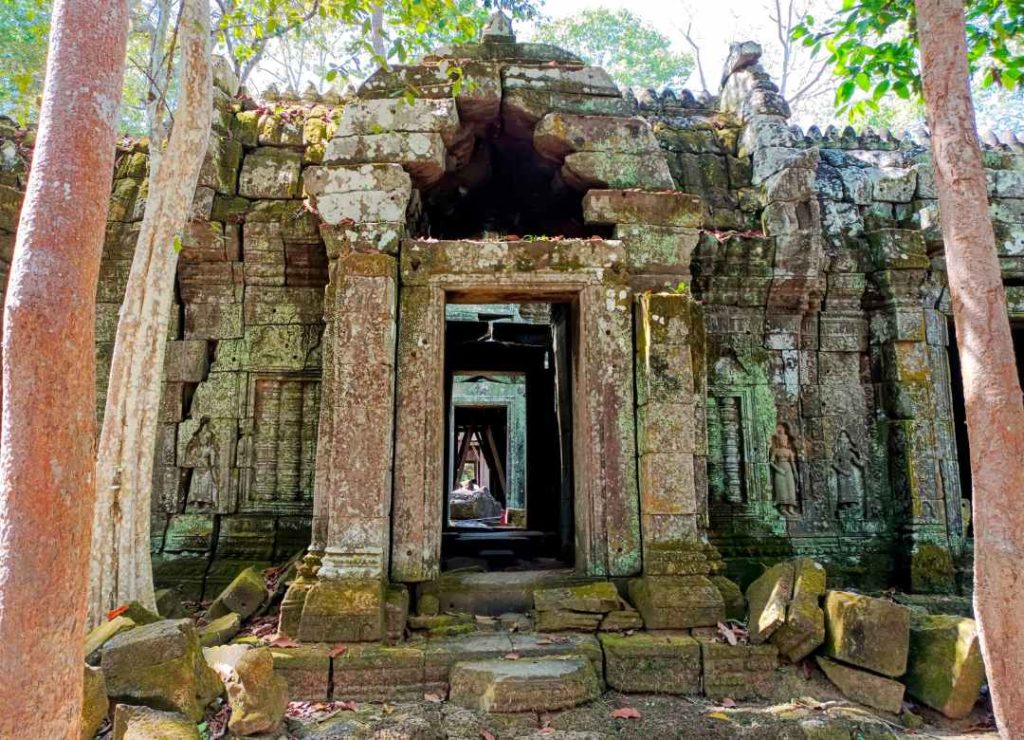
The Visitor Experience: What It’s Like to Explore Ta Nei
Walking the narrow dirt path toward Ta Nei creates immediate excitement. The jungle thickens, sounds of distant tourists fade, and suddenly the ancient stones appear through the trees.
The temple’s peaceful atmosphere allows for a more personal connection with history. You can touch the ancient stones, notice the fine details of carvings, and stand in silence imagining the temple as it once was.
Many visitors describe the experience as “magical” or “how I imagined Angkor would be.” Without ropes, barriers, or crowds, Ta Nei offers a sense of discovery that’s hard to find at more popular sites.
Photography tips for Ta Nei:
- Early morning light creates beautiful rays through trees
- The eastern entrance frames nice shots looking into the temple
- Look for details like carvings partially covered by moss
- Include some of the surrounding jungle to capture the atmosphere
- The contrast between stone and greenery makes for striking images
Most visitors spend about 45-60 minutes at Ta Nei. This gives enough time to explore all areas, take photos, and simply enjoy the peaceful setting before moving on to other temples.
Planning Your Visit: Practical Information
Getting to Ta Nei requires some planning, as it’s off the main tourist routes. Here’s what you need to know:
Transportation and Access
Ta Nei sits about 1.5 km north of Ta Keo temple, accessed via a narrow dirt road through the forest. Options for reaching it include:
- Tuk-tuk: Most common and convenient. Any driver can take you, though some might need directions.
- Private car/van: Comfortable but must stop at the narrow trail entrance; you’ll walk the final stretch.
- Bicycle: Possible for active travelers, but the path can be sandy or muddy.
Directions: From the Small Circuit road near Ta Keo, look for a small dirt track heading north. Follow this about 1.5 km until you reach the temple clearing. During wet season, the path might be muddy.
Tickets and Fees
Ta Nei is included in the standard Angkor Archaeological Park pass. No separate ticket is needed. Current Angkor pass options:
- One-day pass: $37
- Three-day pass: $62
- Seven-day pass: $72
Buy your pass at the main Angkor ticket office on Road 60, before entering the archaeological park.
What to Bring
Since Ta Nei has no facilities or vendors nearby, come prepared:
- Water (at least 1 liter per person)
- Sun protection (hat, sunscreen)
- Insect repellent (especially during rainy season)
- Good walking shoes (the ground is uneven)
- Camera with spare battery
- Small first aid kit (for minor scrapes)
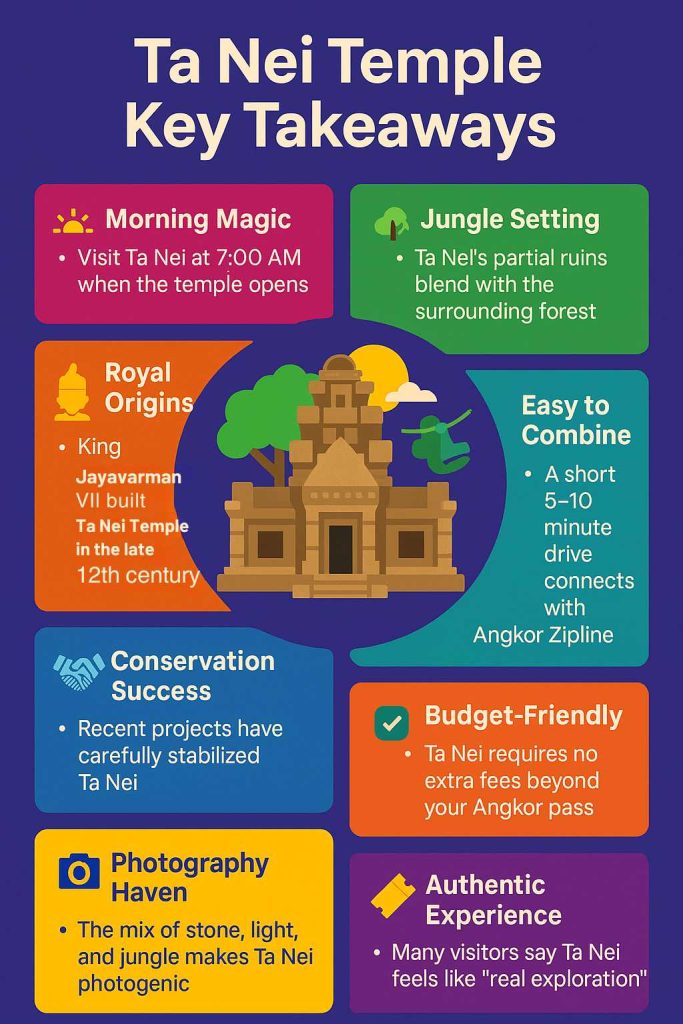
Editor’s Note: Seasonal Considerations
Each season offers a different experience at Ta Nei:
- Dry season (November-April): Easier access with dry paths, less vegetation, good lighting.
- Rainy season (May-October): More challenging access but lush greenery, fewer tourists, and dramatic skies for photography.
Ta Nei in Your Angkor Itinerary: Making the Most of Your Time
Ta Nei works well in various Angkor visit plans. Here are some ways to include it in your itinerary:
1. One-Day “Hidden Temples at Dawn” Tour
For travelers with limited time but wanting to avoid crowds, this early morning tour offers a perfect mix of famous and secret spots:
6:20 AM: Pickup from your Siem Reap hotel
7:00 AM: Arrive at Ta Nei Temple for opening time
8:30 AM: Join the Angkor Zipline Gold Eco-Adventure Canopy Tour (2.5 hours)
11:30 AM: Refresh break after the zipline adventure
12:00 PM: Lunch at a typical Khmer house near Preah Dak village
1:30 PM: Visit Pre Rup temple
3:00 PM: Explore Ta Prohm Temple
4:30 PM: Return to Siem Reap
This tour can pair perfectly with the Private Angkor Wat Sunrise Tour on another day, which covers the main highlights like Angkor Wat, Bayon Temple, and Prasat Preah Khan.
Ta Nei Temple Tour Case Study: The Ta Nei Early Bird Adventure Tour
Innovative Tour Design Elements
This case study examines an integrated tour experience that positions Ta Nei Temple as the centerpiece of a thoughtfully designed day in the Angkor region. The tour begins with early morning hotel pickup (6:20 AM) in Siem Reap, bringing visitors to Ta Nei for opening time (7:00 AM) when lighting conditions are optimal and crowds are absent. This timing strategy maximizes the contemplative potential of the temple environment while creating ideal conditions for photography and quiet appreciation of architectural details.
Adventure and Cultural Integration
Following the temple visit, the tour transitions to an adventure component through the Angkor Zipline Gold Eco-Adventure Canopy Tour, lasting approximately 2-2.5 hours. This activity provides a unique perspective on the forest canopy surrounding the Angkor temples, with visitor feedback indicating high satisfaction with both safety measures and guide quality. The zipline experience includes seven distinct lines and six sky bridges within the treetops, with the 300-meter “honeymoon zipline” receiving particular praise from participants3.
Comprehensive Cultural Experience
The tour continues with a carefully sequenced progression of experiences, including a relaxing lunch at a traditional Khmer house near Preah Dak village that offers authentic culinary experiences while supporting local communities. The afternoon includes exploration of Pre Rup temple before concluding at the more famous Ta Prohm Temple, creating a journey that progresses from secluded to more visited sites throughout the day. This structure allows visitors to experience both hidden gems and iconic landmarks in a single well-planned itinerary.
Complementary Tour Integration
This Ta Nei-focused experience is designed to pair effectively with the “Private Angkor Wat Sunrise Tour,” creating a comprehensive two-day Angkor exploration strategy. The complementary tour includes Angkor Wat at sunrise, Bayon Temple, Prasat Preah Palilay, and concludes at Prasat Preah Khan temple. Together, these tours provide visitors with a balanced experience that includes both iconic monuments and lesser-known temples, offering a more nuanced understanding of Angkor’s architectural and historical diversity.
2. Three-Day Complete Angkor Experience
For those with more time, a three-day plan allows for depth:
Day 1: Main temples (Angkor Wat, Bayon, Ta Prohm)
Day 2: Lesser-known temples including Ta Nei, plus Angkor Zipline adventure
Day 3: Countryside with the Angkor Wat to Siem Reap Floating Village tour
3. Photographer’s Special Itinerary
If photography is your passion:
Early morning: Ta Nei for jungle light and empty ruins
Mid-morning to afternoon: Other photogenic spots like Preah Khan
Evening: Sunset at Pre Rup or Phnom Bakheng
Time management tip: Allow 45-60 minutes for Ta Nei plus 30 minutes total travel time from main roads.
Nearby Attractions: Extending Your Adventure
Ta Nei works well as part of a circuit with several nearby attractions. Each offers something different while staying off the main tourist trail:
1. Ta Keo Temple
Located just 1.5 km south of Ta Nei, Ta Keo is a massive pyramid-temple with steep stairs leading to impressive views. Built earlier than Ta Nei (during the 10th-11th centuries), it shows different architectural styles. Its massive uncarved stone blocks create a stark, imposing presence compared to Ta Nei’s more detailed work.
2. Angkor Zipline
The Angkor Zipline adventure operates very close to Ta Nei, making them perfect to combine. This eco-adventure lets you soar above the forest canopy on a series of ziplines, sky bridges, and platforms. The 2-2.5 hour tour includes:
- 10 ziplines through the forest
- 2 suspended sky bridges
- 1 “spiderman” bridge
- 1 abseil descent
- A guided nature walk
Prices start at $49 for adults, with transportation options available. Check the official Angkor Zipline website for current packages and booking information.
3. Preah Khan Temple
A bit further but worth the trip, Preah Khan offers a larger version of Ta Nei’s jungle-temple atmosphere. This sprawling complex features long corridors, a two-story pavilion, and abundant tree growth. It’s more restored than Ta Nei but less crowded than Ta Prohm.
4. East Baray
This massive reservoir near Ta Nei once supplied water to Angkor’s complex hydraulic system. While mostly dry today, its banks provide context for understanding how the Khmer Empire managed water. The southeastern corner offers nice views and a glimpse into Angkor’s engineering prowess.
What Visitors Say: Reviews and Impressions
Travelers consistently praise Ta Nei for offering an authentic experience away from crowds. Here are some typical comments:
“Ta Nei was the highlight of our Angkor visit. While everyone else packed into Ta Prohm, we had this amazing temple completely to ourselves.” – Mark T., Australia
“The light filtering through trees onto the moss-covered stones created the most magical atmosphere. My best photos from Cambodia were taken here.” – Sarah L., USA
“Our guide took us early morning, and we were the only people there. The silence and peacefulness really let us connect with the history.” – Jean P., France
Common themes in visitor feedback include:
- Appreciation for the lack of crowds
- The special atmosphere created by jungle surroundings
- The authentic “discovery” feeling compared to more developed temples
- The quality of photography opportunities
- The value of visiting early morning for best lighting and experience
Frequently Asked Questions about Ta Nei Temple
How do I get to Ta Nei Temple from Siem Reap?
Most visitors hire a tuk-tuk or join a guided tour. The temple is about 15 km from Siem Reap (30-40 minutes by tuk-tuk). Make sure your driver knows where Ta Nei is located, as some might not be familiar with it.
Is Ta Nei included in the regular Angkor pass?
Yes, Ta Nei is part of the Angkor Archaeological Park and covered by standard Angkor passes (1-day, 3-day, or 7-day). No extra ticket is needed.
How much time should I spend at Ta Nei?
45-60 minutes is enough for most visitors to explore the temple thoroughly, take photos, and enjoy the atmosphere.
Are there guides available at Ta Nei?
Unlike major temples, Ta Nei doesn’t have guides waiting on-site. Hire a guide in Siem Reap who knows about Ta Nei or book a tour that includes it.
Is Ta Nei Temple suitable for children or people with mobility issues?
The path to Ta Nei and the temple grounds are uneven with some obstacles. Active children will enjoy the “adventure” aspect, but those with serious mobility challenges might find it difficult to access.
What’s the best time of year to visit Ta Nei?
The temple is beautiful year-round. Dry season (November-April) offers easier access, while rainy season (May-October) brings lush greenery but potentially muddy paths.
Can I combine Ta Nei with other temples in one day?
Absolutely! Ta Nei works well with nearby temples like Ta Keo and Ta Prohm. Many visitors combine it with the Angkor Zipline adventure for a mix of culture and fun.
Are there restrooms, food, or drink vendors at Ta Nei?
No facilities exist at the temple itself. The closest services are back on the main circuit roads. Bring water and snacks with you.
Is photography allowed at Ta Nei?
Yes, photography for personal use is permitted and encouraged. The temple offers many great photo opportunities.
How does Ta Nei compare to Ta Prohm (the “Tomb Raider” temple)?
Ta Nei offers a similar “jungle temple” atmosphere to Ta Prohm but on a smaller scale and with almost no crowds. Many visitors find Ta Nei more peaceful and authentic, while Ta Prohm is larger and more dramatic.
Ta Nei Temple: A Precious Corner of Angkor
Stepping away from tourist crowds to find Ta Nei Temple offers rewards beyond the typical Angkor experience. This small Buddhist sanctuary gives travelers a chance to connect with Cambodia’s past in a personal, meaningful way.
While Angkor Wat dazzles with grandeur and Ta Prohm amazes with its tree-strangled drama, Ta Nei charms with quiet dignity and authenticity. Its crumbling corridors and moss-covered carvings tell stories going back 800 years, waiting for those willing to venture just a bit off the main path.
To make the most of your Ta Nei visit:
- Go early morning for the best light and atmosphere
- Bring water and wear good walking shoes
- Consider combining it with the nearby Angkor Zipline adventure
- Take time to sit quietly and absorb the peaceful setting
- Look for small details like carvings and the play of light on stone
Want to visit Ta Nei with expert guidance? Our private tours can take you there at the perfect time. Check out our guided tour options or contact us to create a custom itinerary featuring this special temple alongside other Angkor treasures.
Brought to you by Dan and Mat, Your tour planners.
Featured
Explore more on My Siem Reap Tours
Koh Ker and Beng Mealea guided tour | Banteay Srei temple guided tour | Angkor Wat Sunrise tour | Private Angkor Wat Sunset Tour | Koh Ker and Beng Mealea guided tour | Morning Siem Reap floating village tour | Afternoon Siem Reap floating village tour | Private Angkor Wat special tour | Kulen Waterfall small group guided Tour | Private Angkor Wat mix temples photo tour
